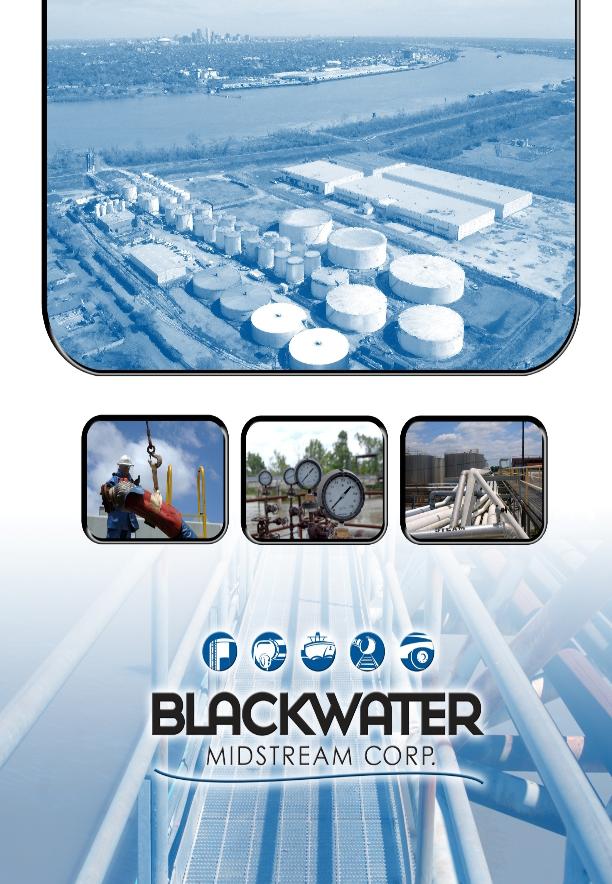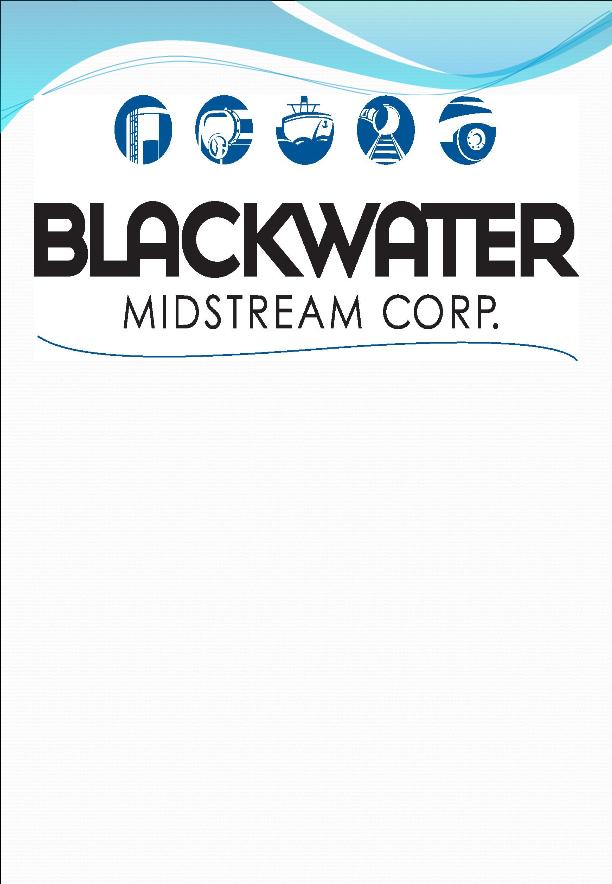Attached files
| file | filename |
|---|---|
| 8-K - BLACKWATER 8-K - Blackwater Midstream Corp. | bwms_8k-022510.htm |
Exhibit 10.1

NASDAQ
OTC BB Symbol: BWMS

BWMS
Small-Cap
Virtual Conference
February 23, 2010
Small-Cap
Virtual Conference
February 23, 2010
2

ORGANIZATION
v In
February 2008, a group of private investors:
ü Changed
the name of the Company to Blackwater Midstream
Corp. (OTC Symbol: BWMS),
Corp. (OTC Symbol: BWMS),
ü Appointed
a new Board of Directors,
ü Appointed
a new Management Team :
Michael
Suder - Chief Executive Officer
Dale
Chatagnier - Chief Operations Officer
Francis
Marrocco - Chief Commercial Officer
ü Designated
a business objective to develop and operate
independent bulk liquid storage terminals.
independent bulk liquid storage terminals.
3

ORGANIZATION
4

v Blackwater’s
management team has collectively over 50 years
experience developing, building and expanding independent
liquid terminal facilities.
experience developing, building and expanding independent
liquid terminal facilities.
v Management
has consistently demonstrated their ability while
with Delta Terminal Services, Kinder Morgan, LBC, and Canal
Barge to acquire underperforming assets, improve the acquired
facility operations, and greatly increase the financial
performance of the assets (e.g. terminal locations at Harvey,
LA; Cincinnati, OH; Baton Rouge, LA; Staten Island, NY;
Chicago, IL).
with Delta Terminal Services, Kinder Morgan, LBC, and Canal
Barge to acquire underperforming assets, improve the acquired
facility operations, and greatly increase the financial
performance of the assets (e.g. terminal locations at Harvey,
LA; Cincinnati, OH; Baton Rouge, LA; Staten Island, NY;
Chicago, IL).
v Management
has extensive relationships with major customers
(e. g. petroleum refiners, chemical manufacturers, and product
traders & brokers) and a proven track record of securing long
term contracts for terminal and ancillary services.
(e. g. petroleum refiners, chemical manufacturers, and product
traders & brokers) and a proven track record of securing long
term contracts for terminal and ancillary services.
MANAGEMENT TEAM
5

STORAGE
TERMINALS and
INDUSTRY POTENTIAL
INDUSTRY POTENTIAL
v Midstream
terminal assets offer an attractive, low risk
opportunity to invest in the petroleum, chemical and
agricultural products sectors without taking commodity
price risk.
opportunity to invest in the petroleum, chemical and
agricultural products sectors without taking commodity
price risk.
v The Lower
Mississippi/ Gulf Coast region of the United
States has a chronic shortage of terminal storage for oil,
refined products, agricultural and chemical liquids.
States has a chronic shortage of terminal storage for oil,
refined products, agricultural and chemical liquids.
6

v Storage
assets typically have high operating margins, in the
60-65% EBITDA margin range.
60-65% EBITDA margin range.
v Third-party
terminalling businesses are generally
independent operations that support many different
commercial customers including refiners, blenders, traders
and marketers.
independent operations that support many different
commercial customers including refiners, blenders, traders
and marketers.
v Income is
derived from tank leasing, operational charges
associated with blending services and throughput charges for
receipt and delivery options.
associated with blending services and throughput charges for
receipt and delivery options.
STORAGE
TERMINALS and
INDUSTRY POTENTIAL
INDUSTRY POTENTIAL
7

v Bulk
liquid terminals store a range of products including
crude oil, bunker fuel, gasoline, distillate, diesel, jet fuel,
chemicals, agricultural products, bio-diesel.
crude oil, bunker fuel, gasoline, distillate, diesel, jet fuel,
chemicals, agricultural products, bio-diesel.
v The
importance of bulk terminal facilities in the refined
product segment supply chain has grown significantly
over the past decade as the nation’s product supply
patterns have become increasingly more complex.
product segment supply chain has grown significantly
over the past decade as the nation’s product supply
patterns have become increasingly more complex.
STORAGE
TERMINALS and
INDUSTRY POTENTIAL
INDUSTRY POTENTIAL
8

BLACKWATER’S
WESTWEGO,
LA TERMINAL
LA TERMINAL
The
facility consists of:
v 26.5
acres, which includes up to 5 acres of expansion
capability,
capability,
54
Tanks - ranging in size from 4,700 to 102,000 barrels ,
Total
Facility Capacity: 902,000
barrels,
Current
Leased Capacity approx. 714,000 barrels,
for a
current utilization rate of 78%.
v As of
December 2008, the terminal had gross revenues of
$2.4 million per year.
$2.4 million per year.
v As of
April, 2010 and upon completion of the third new
tank, contracted revenues have been increased to
annualized rate of $5.6 million.
tank, contracted revenues have been increased to
annualized rate of $5.6 million.
9

vBlackwater
has recently announced a facility
expansion that includes three 50,000 barrel tanks =
$1,750,000. First two tanks were completed in
February 2010, the third will be on line by April
2010.
expansion that includes three 50,000 barrel tanks =
$1,750,000. First two tanks were completed in
February 2010, the third will be on line by April
2010.
vConstruction
of a Mississippi River
ship
dock=$2,500,000. Scheduled
completion April 2010.
v2010
Revenue budget is $6.3 million with an
EBITDA budget of $4.350 million.
EBITDA budget of $4.350 million.
v2010 -
2011-Further expansion possible on 5 acres
for approximately 300,000 barrels of storage -
estimated capital cost is $4,500,000 for Phase II
expansion.
for approximately 300,000 barrels of storage -
estimated capital cost is $4,500,000 for Phase II
expansion.
BLACKWATER’S
WESTWEGO, LA
TERMINAL
TERMINAL
10

Marketing
Strategy:
vTo
specific industries and products that require value
added services at a site that is well positioned
geographically in their supply chain.
added services at a site that is well positioned
geographically in their supply chain.
vThis
years growth has been based on the facility’s
strengths, which are the size of the tanks, and the
modal flexibility available at the site.
strengths, which are the size of the tanks, and the
modal flexibility available at the site.
BLACKWATER’S
WESTWEGO,
LA TERMINAL
LA TERMINAL
11

vThe
marine, rail, and truck product handling
capabilities attract the following industries:
capabilities attract the following industries:
Vegetable
Oils
Commodity
Chemicals
Drilling
Fluids
Specialty
Chemicals
Molasses
Products
Petroleum
Products
BLACKWATER’S
WESTWEGO,
LA TERMINAL
LA TERMINAL
12

BLACKWATER’S
GROWTH
vIn the
current environment of scarce storage
capacity and availability in the Gulf Coast region, the
opportunity exists for Blackwater Midstream to
grow:
capacity and availability in the Gulf Coast region, the
opportunity exists for Blackwater Midstream to
grow:
ü Efficiently
within the Westwego, LA
terminal fence line.
terminal fence line.
ü Taking
advantage of a reduced project
cost by
utilizing the existing
infrastructure of the facility and the
inherent
economies of scale.
13

BLACKWATER’S
GROWTH
Forecasted Growth
at the Westwego, LA Terminal
*Does not
include BWMS overhead or debt service
14
|
YEAR
|
2009
|
2010
|
2011
|
2012
|
|
BARRELS
|
752,000
|
902,000
|
1,202,000
|
1,202,000
|
|
REVENUE
|
$3,470,000
|
$6,300,000
|
$10,050,000
|
$10,783,000
|
|
EBIDTA
|
$2,462,000
|
$4,350,000
|
$6,750,000
|
$7,383,000
|

BLACKWATER’S
GROWTH
vBlackwater’s
“roll-up” strategy is to acquire
underperforming, non-strategic, niche terminalling
assets which will enable the Company to build a
diversified asset base and mitigate business risk.
underperforming, non-strategic, niche terminalling
assets which will enable the Company to build a
diversified asset base and mitigate business risk.
v
Blackwater has announced a second acquisition for
a
160,000 barrel terminal in Brunswick, Georgia
that is
expected to close within the first quarter
2010.
2010.
15

*The
forecasted projections presented
contain forward-looking statements that
are based on management’s expectations,
estimates, projections and assumptions.
Forward-looking statements are made
pursuant to the safe harbor provisions of
the Private Securities Litigation Reform Act
of 1995, as amended. These statements
are not guarantees of future performance
and involve certain risks and uncertainties,
which are difficult to predict. Therefore,
actual future results and trends may differ
materially from what is forecast in forward-
looking statements due to a variety of
factors.
contain forward-looking statements that
are based on management’s expectations,
estimates, projections and assumptions.
Forward-looking statements are made
pursuant to the safe harbor provisions of
the Private Securities Litigation Reform Act
of 1995, as amended. These statements
are not guarantees of future performance
and involve certain risks and uncertainties,
which are difficult to predict. Therefore,
actual future results and trends may differ
materially from what is forecast in forward-
looking statements due to a variety of
factors.
